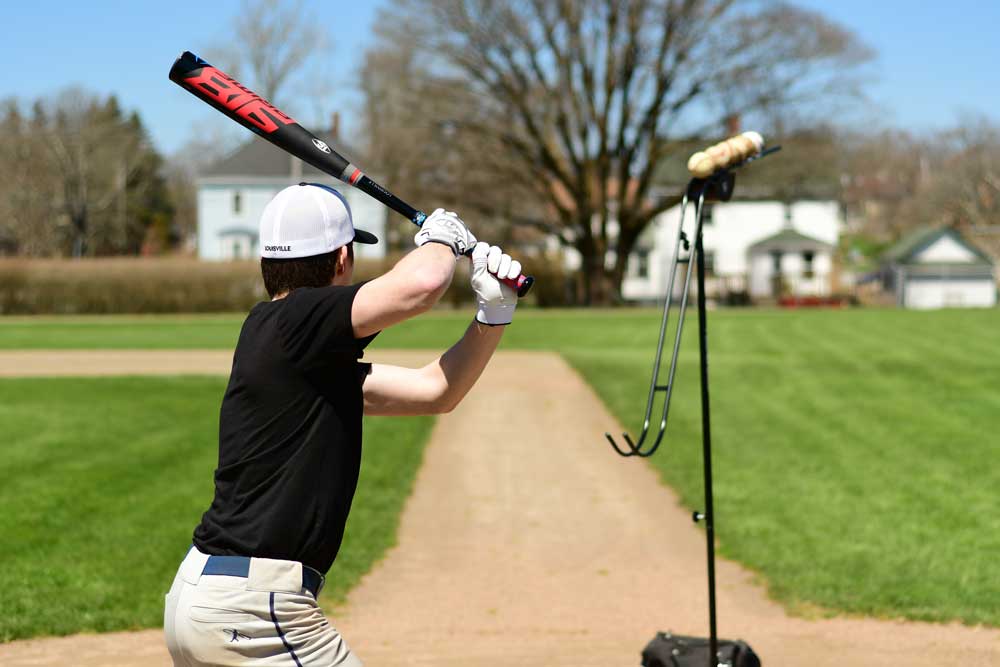Baseball pitchers should practice 3-4 times per week. Frequency varies with individual goals and training phases.
Developing and maintaining pitching skills is crucial for baseball players aiming to excel in the sport. Proper practice frequency ensures consistent advancement in technique, strength, and accuracy. Seasoned athletes tailor their training to peak at the right time, while beginners focus on grasping the fundamentals.
Engaging in pitching sessions multiple times a week allows for muscle memory development and refinement of pitching mechanics. It’s essential to balance intense workouts with adequate rest to prevent overuse injuries. Empirical evidence suggests that rest days are as important as practice days in enhancing overall performance and sustainability of a player’s pitching career. Coaches and trainers play a pivotal role in designing training programs that optimize frequency and intensity while accounting for individual athlete’s needs and the rigors of the baseball season.
Pitching Practice Frequency: Balancing Progress And Health
Mastering the art of pitching in baseball requires regular practice. Yet, too much can harm your body. Striking the right balance keeps your arm strong and safe.
Key Factors Determining Practice Sessions
To plan your pitching practice, consider these elements:
- Age: Younger players need more rest.
- Skill Level: Advanced pitchers might practice more.
- Physical Fitness: Fitter players recover faster.
- Season: Off-season and in-season training differ.
Risk Of Overuse Injuries In Pitchers
Practicing too often can lead to inju
ries. Here’s what to watch out for:| Injury Type | Cause | Prevention |
|---|---|---|
| Tendinitis | Repetitive stress | Regular rest days |
| Elbow Injuries | Excessive force on joints | Proper technique |
| Shoulder Strain | Overuse of shoulder muscles | Strength training |
The Importance Of Structured Routines
The Importance of Structured Routines cannot be overstated for baseball pitchers. Adherence to a structured practice routine is crucial to developing consistency, enhancing muscle memory, and reducing the risk of injury. Through predictable training patterns, pitchers can gradually increase their skills and stamina.
Developing A Consistent Pitching Schedule
Crafting the right balance between practice, rest, and play is essential for pitchers at any level. A consistent schedule allows for dedicated time to focus on mechanics, control, and strength training. It also ensures that a pitcher’s arm gets the necessary rest to recover and rebuild.
- Daily throwing with varied intensity helps maintain arm health.
- Specific drill work two to three times a week can sharpen skills.
- Long toss sessions should be included to build arm strength.
- Adequate rest days are essential to prevent overuse injuries.
Examples From Professional Pitchers’ Regimens
Many top performers in the big leagues stick to a meticulous pitching schedule. Let’s look at how professional pitchers structure their routines.
| Pitcher | Daily Routine | Weekly Schedule |
|---|---|---|
| Max Scherzer | Dynamic stretching, long toss | Tue: High-intensity bullpen session Thu: Light bullpen, strength training Sat: Game day |
| Clayton Kershaw | Resistance band workouts, short toss | Mon: Bullpen session Wed: Recovery, core workouts Fri: Game prep |
In both examples, athletes emphasize a combination of throwing exercises, conditioning, and recovery throughout the week. Careful attention to these aspects is paramount for optimum performance and sustainability.
Age-specific Guidelines For Young Pitchers
Developing a young pitcher’s skills is crucial in baseball. But knowing how often they should practice pitching can be tricky. The right frequency of pitching practice is essential for growth and avoiding injury. Let’s explore age-specific recommendations to ensure young players stay safe and improve their game effectively.
Recommendations For Youth Pitchers
For pitchers under 10 years old, structured pitching practice should be minimal. They should focus on fundamental movements and mechanics rather than on the number of pitches. Here are some key recommendations:
- Pitch no more than 50 pitches per game.
- Ensure 2-3 days rest between pitching sessions.
- Limit pitching to 2 games per week.
Following a pitch count and rest protocol is important to protect young arms from overuse injuries.
Adjustments As Pitchers Mature
As pitchers grow older, their bodies can handle more stress. This allows for increased pitch counts and practice sessions. For pitchers aged 11-14:
| Age | Pitches per Game | Rest Days |
|---|---|---|
| 11-12 years | 75 | 3-4 days |
| 13-14 years | 95 | 4 days |
Remember to focus on quality over quantity. A mature pitcher should also include strength and conditioning to their routine, balancing pitching practice with overall fitness.
By gradually increasing the workload and keeping a close eye on how their arms respond, young pitchers can develop effectively while reducing the risk of injury.
Offseason Vs. In-season Pitching Routines
Perfecting the art of pitching in baseball requires dedication and smart practice. Knowing how often to engage in pitching exercises can make a significant difference in a player’s performance. Differences in routines are essential, particularly when comparing the offseason and in-season periods. The way pitchers manage their training schedules can have profound impacts on their arm strength, technique, and overall game-day preparedness.
Maintaining Arm Strength Year-round
A pitcher’s arm is their most valuable asset. Keeping it strong all year is crucial. During the offseason, this doesn’t mean pitching at full intensity. Instead, focus on general conditioning and strength training. Light throwing and resistance exercises maintain muscle without overtaxing the arm.
Periodization Strategies For Pitchers
Periodization involves structured training phases. Each phase targets specific goals, adjusting a pitcher’s routine over the course of a year. Start with the offseason, when recovery and building fundamental strength are the focus. Gradually increase throwing intensity as the season approaches. Maintain peak form during the season, then taper off as it ends. This cycle helps ensure a pitcher’s arm stays healthy and ready to perform.
- Offseason: Rest, recovery, and slow buildup
- Preseason: Ramp up intensity and volume
- In-Season: Maintenance and in-game stamina
- Postseason: Active rest and injury assessment
| Phase | Goals | Activities |
|---|---|---|
| Offseason | Build muscle, improve flexibility | Weight training, stretching, light throwing |
| Preseason | Increase throwing, refine pitches | Throwing drills, bullpen sessions |
| In-Season | Maintain performance, manage fatigue | Regular pitching, strategic rest |
| Postseason | Recover, address injuries | Reduced throwing, medical check-ups |
Daily Practices From Warm-up To Cool-down
Mastering the art of pitching in baseball involves discipline and a consistent routine. Each practice session should encompass a series of structured activities. These activities range from dynamic warm-ups to specific cool-down techniques. Together, they optimize performance and minimize the risk of injury. Let’s dive into the fundamental exercises and methods that should be a part of a pitcher’s daily regimen.
Crucial Warm-up Exercises Before Pitching
Before stepping onto the mound, a proper warm-up prepares the body for the physical demands of pitching. Start with dynamic stretches that target the shoulders, arms, and legs. Here is a list of essential warm-up exercises:
- Arm Circles: Loosen up the shoulder joints.
- Jogging: Increase overall body temperature.
- Leg Swings: Enhance hip mobility.
- High Knees: Activate the leg muscles.
These exercises gradually increase heart rate and enhance muscle flexibility. They are vital for a pitcher’s performance and safety.
Cool-down Techniques To Prevent Injury
After rigorous pitching, a cool-down phase aids in muscle recovery. It reduces the likelihood of injury. Let’s look at the crucial elements of an effective cool-down:
- Gentle Jogging: Lower the heart rate gradually.
- Stretching: Focus on the arms, shoulders, and back.
- Breathing Exercises: Calm the body and mind.
Incorporate these cool-down activities to ensure muscles remain flexible and strong. Proper recovery tactics safeguard a pitcher’s arm and career longevity.

Credit: www.bostonglobe.com
The Role Of Rest Days In A Pitching Schedule
Pitchers need rest days just as much as they need practice. Rest days help muscles heal. Without rest, arms grow weary, and performance can drop. Including rest days in a pitching schedule is key. This balance keeps pitchers at their best. Let’s explore how strategic rest and active recovery play a part.
Strategic Rest For Arm Recovery
Arm health is vital for pitchers. Throwing a baseball is taxing on the arm. A day off between heavy throwing sessions is wise. It helps the arm’s muscles and tendons recover. This rest time reduces injury risk.
Consider these points for strategic rest:
- Limits: Set a pitch count limit. Avoid overworking the arm.
- Schedule: Plan rest days. Stick to them even if the arm feels okay.
- Observe: Watch for signs of fatigue. Rest immediately if needed.
Active Recovery: Keeping The Body In Motion
Rest doesn’t mean doing nothing. Active recovery keeps muscles limber. Light exercises on rest days can promote healing. These should not strain the arm.
Add these active recovery activities:
| Activity | Purpose |
|---|---|
| Jogging | Boosts overall stamina. |
| Stretching | Increases flexibility. |
| Light catch | Keeps arm active without strain. |
Regular rest and active recovery days help maintain a pitcher’s peak condition. Always listen to the body’s signs. A well-rested pitcher is a more effective pitcher.
Strength Training And Conditioning
Perfecting a baseball pitch calls for more than just regular throwing practice. Strength training and conditioning play a crucial role in boosting your pitching performance. By focusing on these aspects, you can increase your power, stamina, and resistance to injury. Tailored exercises and workouts will keep your pitching form at its peak throughout the season.
Pitching-specific Strength Exercises
Pitchers must develop strong muscles relevant to their sport. The right exercises target areas critical for an effective pitch. These areas include the shoulders, arms, core, and legs. Building muscle in these areas supports better control, speed, and power when pitching. Let’s explore exercises to strengthen these key muscle groups.
- Rotator Cuff Exercises: Essential for shoulder strength and flexibility.
- Wrist Weights: Improve arm speed and strength.
- Medicine Ball Throws: Build core power, crucial for pitching velocity.
- Squats and Lunges: Enhance leg strength, providing a stable base for pitches.
Conditioning Workouts To Improve Endurance
Endurance keeps pitchers strong late into games. Conditioning workouts aim to improve overall stamina, allowing pitchers to maintain performance over extended periods. Here are routines to boost a pitcher’s endurance.
- Interval Running: Mixes sprints and jogging to increase heart rate.
- Cycling: Builds leg endurance without high impact.
- Swimming: Great for full-body endurance and joint health.
- Plyometric Drills: Boosts explosive power and cardiovascular fitness.
Remember, rest is vital. Always allow time for your body to recover between sessions. This helps prevent injury and ensures muscle growth.
Monitoring Pitch Counts And Session Intensity
Mastering the art of pitching in baseball requires regular practice, but how much is too much? Monitoring pitch counts and session intensity ensures sustained progress without overexerting the arm. It’s all about finding that sweet spot between honing skills and staying healthy.
Tools For Tracking Pitches
Keeping a close eye on the number of pitches thrown is crucial for every aspiring pitcher. Here are some tools to help:
- Digital pitch counters: Compact and easy to use, they record every throw with a click.
- Pitching apps: Smartphones can now track pitches, types of pitches, and rest days.
- Smart baseballs: These tech-savvy balls provide data on pitch count, spin rate, and speed.
Adapting Workloads Based On Pitch Count Data
Proper analysis of pitch count data leads to smarter training regimes. Here’s how data shapes workload:
- Review daily and weekly pitch counts.
- Adjust intensity based on these numbers.
- Plan rest days to prevent fatigue.
- Customize sessions to focus on areas needing improvement without overloading the arm.
Remember, quality trumps quantity every time in baseball pitching practice. Pitch count data helps to keep training on target.
Developing And Evaluating Pitching Mechanics
Mastering the art of pitching in baseball requires dedication and practice. Sharpening pitching mechanics has profound effects on speed and accuracy. A structured practice schedule helps pitchers develop consistent moez-toction, building muscle memory. Effective evaluation ensures constant development and prevents the formation of bad habits that can lead to injuries.
Technical Drills To Refine Mechanics
Drills play a vital role in enhancing pitching skills. Regularly engaging in technical drills maximizes control and minimizes stress on the arm. Let’s explore key exercises designed to bolster pitching prowess:
- Towel Drill: Emulates throwing motion using a towel, perfecting arm path.
- Knee Drill: Focuses on the upper body mechanics, improving arm action.
- Wall Drill: Teaches body control and proper leg utilization.
- Bullpen Sessions: Mimics game conditions, aiding in consistency.
Using Video Analysis For Improvement
Video analysis transforms the way pitchers evaluate their form. It offers an objective view, pinpointing areas that need work. Implementing video review involves several steps:
- Record pitching sessions from multiple angles.
- Analyze the footage for technique and body alignment.
- Compare with professional pitchers to identify disparities.
- Adjust mechanics and monitor progress over time.
Consistent use of video analysis accelerates improvements and cements superior pitching techniques.

Credit: www.newsday.com
When To Seek Professional Instruction
Mastering the art of pitching in baseball takes dedication and countless hours of practice. Yet sometimes, solo drills and team exercises are not enough to perfect your throw. Knowing when to seek professional instruction can make the difference between a good pitcher and a great one.
Signs You Need A Pitching Coach
A skilled pitching coach can pinpoint areas for improvement that might be invisible to the untrained eye. Watch for these telltale signs:
- Stagnant skill level: When progress hits a plateau despite regular practice.
- Inconsistent performance: When good days are few and pitches lack predictability.
- Persistent injuries: When aches don’t heal and new pains emerge after playing.
- Technical confusion: When advice from multiple sources leads to conflicting techniques.
Integrating Professional Feedback Into Practice
Once a coach provides insights, it’s crucial to integrate this feedback effectively. Consistency is key. A customized plan ensures steady progress. Frequent reviews with your coach maintain direction and focus. Aim to:
- Outline clear goals with your coach for targeted improvement.
- Set a regular schedule for practice sessions incorporating new tips.
- Keep a detailed journal to track changes and results over time.
- Seek follow-up instruction to adjust the plan as skills evolve.

Credit: sluggertraining.com
Frequently Asked Questions On How Often Should You Practice Pitching Baseball
How Many Days Should You Practice Pitching Baseball?
Aim to practice baseball pitching 3-4 times a week. Ensure each session includes proper warm-ups and cooldowns to prevent injury. Rest days are crucial for muscle recovery.
How Much Pitching Practice Is Too Much?
Overworking a pitcher’s arm can lead to injury. Typically, experts recommend limiting pitching to 75-100 pitches per game and ensuring adequate rest days in between to prevent overuse injuries. Always listen to your body’s signals for fatigue and discomfort.
How Many Days Rest For Pitching?
Pitchers typically require at least 1-5 days of rest between pitching sessions, depending on their workload and individual recovery needs. Proper rest helps prevent arm injuries and maintains performance.
Conclusion
Perfecting your pitching requires consistent, smart practice. Aim for balance—too little won’t yield improvement, too much could lead to injury. Your individual needs should dictate frequency and intensity. Gauge your body’s response, and adjust accordingly. Commitment to a tailored routine promises progress in your baseball pitching skills.

Hello, I am Mark Hertz a full-time blogger and digital content creator. My passion and profession is blogging and sharing with this blog various ways to make money online from internet.



Pingback: Why Does Baseball Have Weird Start Times? Unveiling the Mystery - Bestbaseballsite - Help You play Better Baseball
Pingback: Best Practice Balls for Baseball: Ace Your Swing! - Bestbaseballsite - Help You play Better Baseball